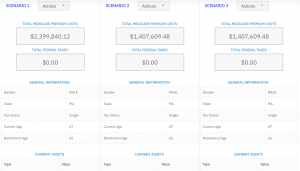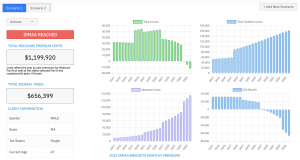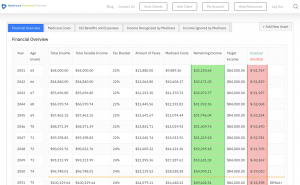Ever found yourself caught off-guard by an unexpected expense? Imagine the surprise when Medicare beneficiaries learn about the Part D penalty. It’s not just any fee. It’s a monthly charge that sticks like glue to your prescription drug plan premium, potentially for life. Why does this happen? Simply put, if there was a period of 63 or more days after your Initial Enrollment Period ended and you were without Medicare Part D or creditable prescription drug coverage, you’ve opened the door to this unwelcome guest.
The formula behind it might sound like something out of a high school math class – involving percentages, national base beneficiary premiums ($34.70 in 2024), and rounding off cents. But don’t be fooled; its implications are very real and can affect your wallet directly. Some dodge this bullet through special circumstances or waivers, but many find themselves navigating these murky waters unexpectedly.
This isn’t merely about avoiding late-night infomercial purchases; it’s an essential aspect of managing healthcare expenses as we age. And while no one enjoys thinking about these costs, being proactive now can save a lot of headaches and financial strain down the line.
Understanding the Medicare Part D Late Enrollment Penalty
What is the Medicare Part D Late Enrollment Penalty?
The late enrollment penalty is akin to a party you didn’t want to attend but ended up having to pay for anyway. If you forgo Medicare drug coverage or similar creditable prescription drug coverage for 63 consecutive days or more after your Initial Enrollment Period, this unwelcome guest adds to your monthly premium.
How is the Medicare Part D late enrollment penalty calculated?
Imagine this: For every month you’re not covered, there’s a 1% charge of the national base beneficiary premium ($34.70 in 2024) added to your bill. It’s rounded to the nearest $.10 and adheres to your monthly Part D premium persistently.
Reasons for incurring Part D penalty
- Not having prescription drug coverage after the Initial Enrollment Period
Avoiding and Managing Late Enrollment Penalties for Part D
Special Circumstances and Waivers
So, you’re thinking about dodging that pesky late enrollment penalty? Good news. You might just slip through if:
- You’ve got creditable drug coverage, which is just as good as Part D.
- You qualify for Extra Help. Yep, it’s a thing.
How to Appeal a Part D Penalty
Gotten yourself a penalty despite your best efforts? Don’t sweat it. Here’s the kicker: you can appeal. Complete a form, shoot it over within 60 days with any proof of creditable prescription drug coverage. Your voice matters—make sure they hear it loud and clear.
Calculating Your Potential Part D Penalty Costs
Understanding Base Beneficiary Premiums
So, you’re wondering how much the Part D penalty could cost you? Let’s break it down. The national base beneficiary premium is not just a mouthful; it’s also the key to figuring out your penalty.
Monthly Penalties Over Time
The deal with penalties is they stick around like that one song stuck in your head. They’re assessed monthly for as long as you have Part D coverage. Late by 10 months? That might seem small at first, but here’s where things get real: As the Part D national base premium goes up, so does your penalty. Yep, it can grow over time.
Navigating Enrollment Periods to Prevent Penalties
Key Enrollment Periods for Medicare Part D Coverage
So, you’re eyeing that Medicare Part D coverage, huh? Smart move. But here’s the deal: timing is everything. Miss your shot and penalties become your new unwanted buddy.
The Initial Enrollment Period (IEP) is your golden ticket. It kicks off three months before you turn 65, includes the month of your birthday, and then lingers like a good friend for another three months after.
If life throws curveballs and you miss it, don’t sweat it too much. There’s something called a Special Enrollment Period (SEP). This gem pops up when certain life events happen – think moving or losing other insurance coverage.
The Impact of Creditable Prescription Drug Coverage on Penalties
Defining Creditable Prescription Drug Coverage
Ever wonder what “creditable prescription drug coverage” actually means? It’s not just fancy talk. This is the kind of coverage that’s at least as good as Medicare’s Part D plan. Think about it like your safety net to avoid paying more than you should.
Creditable coverage could be from an employer, TRICARE, or even the VA. The big deal here? If you’ve got it, you might dodge the dreaded Part D late enrollment penalty. But let time slip—63 days without this coverage—and boom. You’re facing extra charges when signing up for a Medicare drug plan later.
So, always keep tabs on your drug plan status because nobody likes nasty surprises with their health care costs.
How to Dispute a Medicare Part D Penalty Decision
Steps for Filing a Reconsideration Request
Got hit with a late enrollment penalty and it doesn’t sit right? You’re not alone. Here’s how you can challenge that decision.
- Gather Your Evidence: Start by collecting any documents that prove your case. Think notices of creditable coverage or anything else relevant.
- Fill Out the Form: Grab the reconsideration request form from your plan, fill it out completely.
- Send It Off: Mail or fax it back within 60 days after getting the penalty notice. Make sure to tuck in any supporting documents along with your appeal.
If everything checks out, you could see that pesky penalty vanish. Want more details? Check this guide on disputing Part D penalties.
Conclusion
So, we’ve ventured through the maze of Medicare and dodged the traps laid by the part d penalty. It’s not just a fee; it’s a shadow that can follow your healthcare journey for years, sticking closer than an overzealous salesperson at a car dealership.
But here’s the kicker: With some savvy moves and timely action, you can dance around this financial pitfall like you’re in a high-stakes game of hopscotch. We’ve unpacked special circumstances that could be your golden ticket out of penalty land, broken down those math-class nightmares into understandable chunks, and shown how to wield appeals like a knight brandishing their sword against injustice.
Far from piling on more stress, this is about giving you the tools to take control! Knowing how to sidestep penalties means more cash stays in your pocket where it belongs. And let’s face it: who doesn’t love keeping their hard-earned money while navigating health care without stumbling over unexpected costs?
We’ve cracked open the playbook on avoiding unnecessary fees with strategic enrollment timing and understanding creditable coverage—because being proactive is always better than getting caught off guard.
Navigating the intricacies of healthcare costs with finesse isn’t merely savvy; it’s a craft to perfect for both mental serenity and financial prosperity.
Table of Contents:
- Understanding the Medicare Part D Late Enrollment Penalty
- Avoiding and Managing Late Enrollment Penalties for Part D
- Calculating Your Potential Part D Penalty Costs
- Navigating Enrollment Periods to Prevent Penalties
- The Impact of Creditable Prescription Drug Coverage on Penalties
- How to Dispute a Medicare Part D Penalty Decision
- Conclusion
Streamlining the Medicare Surcharge Calculation Process.
Our Healthcare Retirement Planner software is designed to streamline the retirement planning process for financial professionals. By providing an efficient way to calculate IRMAA costs, our tool helps you save time and focus on other aspects of your clients’ retirement plans.
- Faster calculations: Our software quickly calculates IRMAA costs based on your client’s income and tax filing status, eliminating manual calculations and potential errors.
- User-friendly interface: The intuitive design of our platform makes it easy for financial professionals to input data and generate results with minimal effort.
- Data integration: Seamlessly integrate our calculator into your existing financial planning tools or CRM systems for a more streamlined workflow.
- Easy to Understand Reports: Export reports to easily share with your clients
- Tax and Surcharge Modeling: see how different types of income affects both taxes and your surcharges.
In addition to simplifying the calculation process, using our Healthcare Retirement Planner can also help improve communication between you and your clients. With clear visuals that illustrate how IRMAA costs impact their overall retirement plan, you can effectively convey complex information in an easily digestible format. This enables clients to make informed decisions about their healthcare expenses during retirement while ensuring they are prepared for any potential changes in Medicare premiums due to income fluctuations. To learn more about how our software can benefit both you as a financial professional and your clients’ retirement planning experience, visit the features page. Streamlining retirement planning processes can help financial professionals save time and resources, allowing them to focus on other areas of their clients’ needs. Automated calculation of IRMAA costs is the next step in streamlining this process even further.





